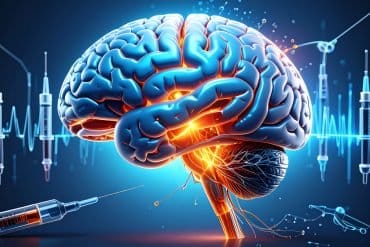Summary: Researchers discovered how stress-induced hormones like cortisol influence the likelihood of developing PTSD.
Using a rat model with a blunted hormonal response to stress, they observed impaired fear extinction, reduced hippocampal volume, and sleep disturbances, all traits associated with PTSD.
Treatment combining cognitive therapy with corticosterone helped alleviate these symptoms, offering insights into potential interventions.
Key Facts:
- Individuals with lower glucocorticoid levels, such as cortisol, are more likely to develop PTSD after traumatic events.
- The study revealed that blunted glucocorticoid responses led to PTSD-related symptoms like impaired fear extinction and sleep disturbances.
- Enhancing glucocorticoid levels post-trauma could potentially mitigate PTSD symptoms and improve recovery.
Source: EPFL
Posttraumatic stress disorder (PTSD) is a debilitating condition that arises after experiencing traumatic events.
While many people experience trauma, only about 25-35% develop PTSD. Understanding the factors that make certain individuals more susceptible is crucial for both prevention and treatment.
A new study led by Carmen Sandi and Simone Astori at EPFL now reveals how the development of PTSD is influenced by glucocorticoids, hormones that our body releases in response to stress, like cortisol.

The work provides significant insights into the behavioral and biological traits associated with PTSD vulnerability.
“There are considerable differences in the levels of glucocorticoids that individuals release to the bloodstream when stressed,” says Carmen Sandi.
“Low glucocorticoid levels are frequently observed in PTSD patients following trauma exposure and were initially suspected to be a consequence of trauma exposure.”
She continues: “The possibility that this could be a trait constituting a preexisting PTSD risk factor has been an outstanding open question for many years, but tackling it has been challenging due to the difficulties of both collecting biological measures before trauma exposure, and having access to relevant animal models in which the causal role of these traits can be investigated.”
To explore how a reduced hormonal response to stress might be linked to PTSD symptoms, the researchers used a genetically selected rat model that mimics people with blunted responses to cortisol.
To do this, the team used MRI scans to measure the volume of different brain regions, trained rats to associate a cue with fear, recorded their sleep patterns, and measured their brain activity.
By combining these methods, the researchers discovered that a blunted responsiveness to glucocorticoids led to a “correlated multi-trait response” that includes impaired fear extinction (in males), reduced hippocampal volume, and rapid-eye movement sleep disturbances.
To explain the terms: Fear extinction is a process by which a conditioned fear response diminishes over time; problems with fear extinction are a hallmark of PTSD. Rapid-eye movement is crucial for memory consolidation, and disturbances in this type of sleep pattern have long been associated with PTSD.
But the study didn’t end there: the researchers treated the rats with the equivalent of human cognitive and behavioral therapy to reduce their learned fears. After that, they gave the rats corticosterone.
As a result, both excessive fear and disturbances in rapid-eye movement sleep receded. Not only that, but the increased levels of the stress-related neurotransmitter norepinephrine in the brain also returned to normal.
“Our study provides causal evidence of a direct implication of low glucocorticoid responsiveness in the development of PTSD symptomatology following exposure to traumatic experiences, i.e., impaired fear extinction,” says Carmen Sandi.
“In addition, it shows that low glucocorticoids are causally implicated in the determination of other risk factors and symptoms that were until now only independently related to PTSD.”
Silvia Monari, the study’s first author, adds: “In a nutshell, we present mechanistic evidence – previously missing – that having low glucocorticoids such as cortisol in humans is a condition for causally predisposed individuals to present all to-date vulnerability factors for developing PTSD, and causally involved in deficits to extinguish traumatic memories.”
About this PTSD research news
Author: Nik Papageorgiou
Source: EPFL
Contact: Nik Papageorgiou – EPFL
Image: The image is credited to Neuroscience News
Original Research: Open access.
“Blunted glucocorticoid responsiveness to stress causes behavioral and biological alterations that lead to posttraumatic stress disorder vulnerability” by Carmen Sandi et al. Biological Psychiatry
Abstract
Blunted glucocorticoid responsiveness to stress causes behavioral and biological alterations that lead to posttraumatic stress disorder vulnerability
Background
Understanding why only a subset of trauma-exposed individuals develop posttraumatic stress disorder is critical for advancing clinical strategies. A few behavioral (deficits in fear extinction) and biological (blunted glucocorticoid levels, small hippocampal size, and rapid-eye-movement sleep [REMS] disturbances) traits have been identified as potential vulnerability factors. However, whether and to what extent these traits are interrelated and whether one of them could causally engender the others are not known.
Methods
In a genetically selected rat model of reduced corticosterone responsiveness to stress, we explored posttraumatic stress disorder–related biobehavioral traits using ex vivo magnetic resonance imaging, cued fear conditioning, and polysomnographic recordings combined with in vivo photometric measurements.
Results
We showed that genetic selection for blunted glucocorticoid responsiveness led to a correlated multitrait response, including impaired fear extinction (observed in males but not in females), small hippocampal volume, and REMS disturbances, supporting their interrelatedness. Fear extinction deficits and concomitant disruptions in REMS could be normalized through postextinction corticosterone administration, causally implicating glucocorticoid deficiency in two core posttraumatic stress disorder–related risk factors and manifestations. Furthermore, reduced REMS was accompanied by higher norepinephrine levels in the hippocampal dentate gyrus that were also reversed by postextinction corticosterone treatment.
Conclusions
Our results indicate a predominant role for glucocorticoid deficiency over the contribution of reduced hippocampal volume in engendering both REMS alterations and associated deficits in fear extinction consolidation, and they causally implicate blunted glucocorticoids in sustaining neurophysiological disturbances that lead to fear extinction deficits.






